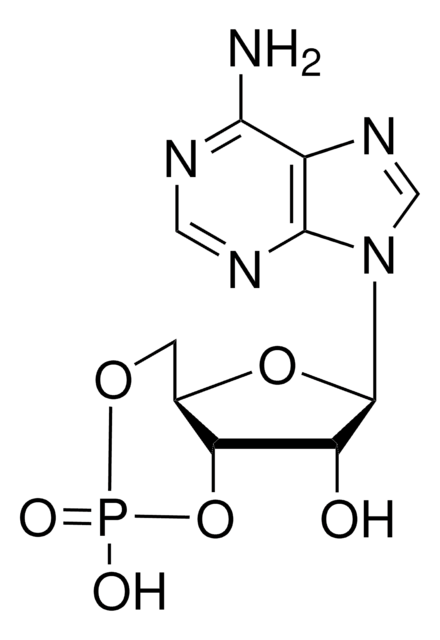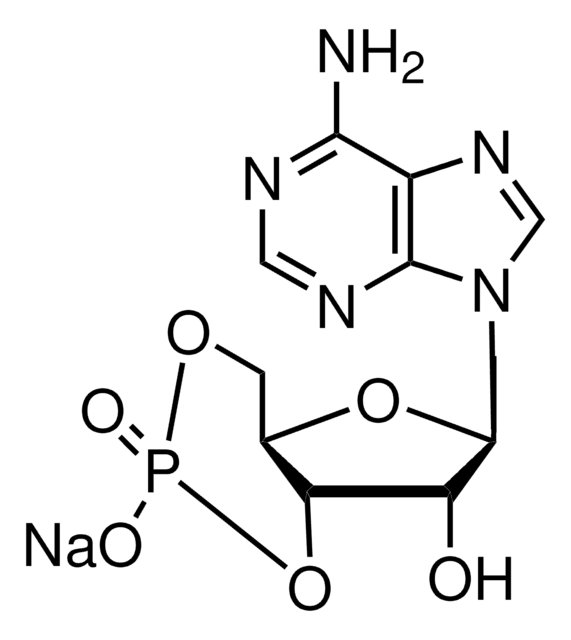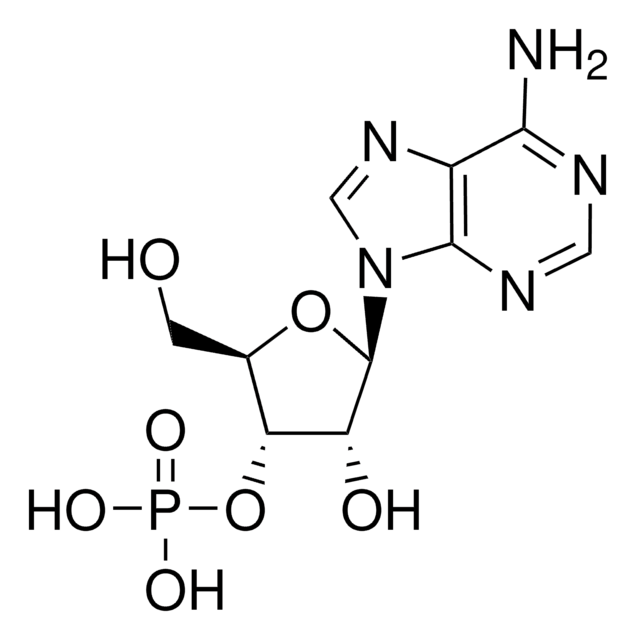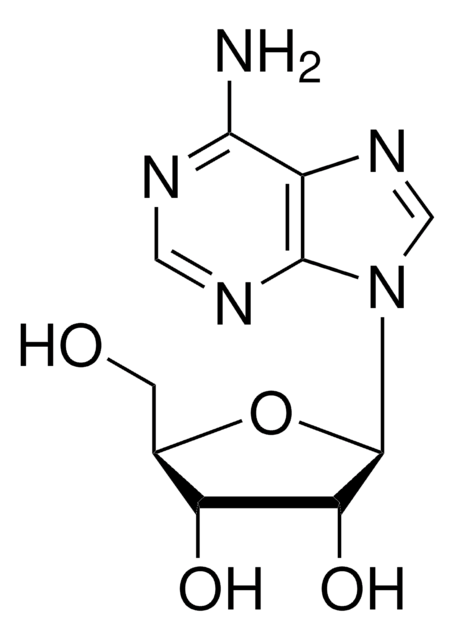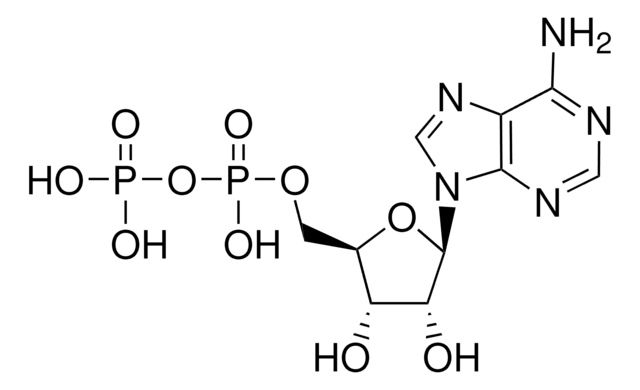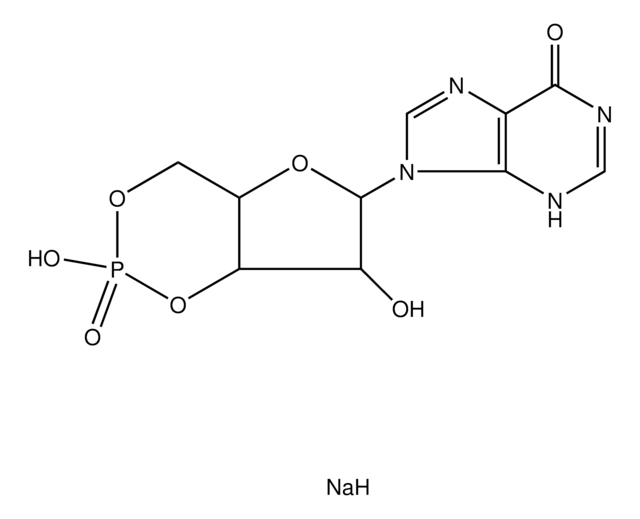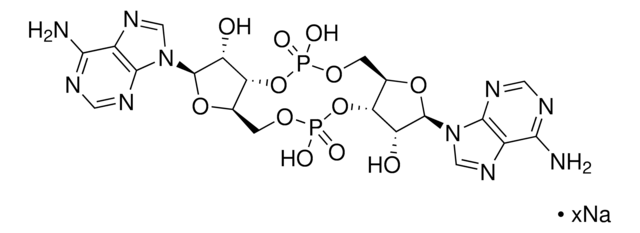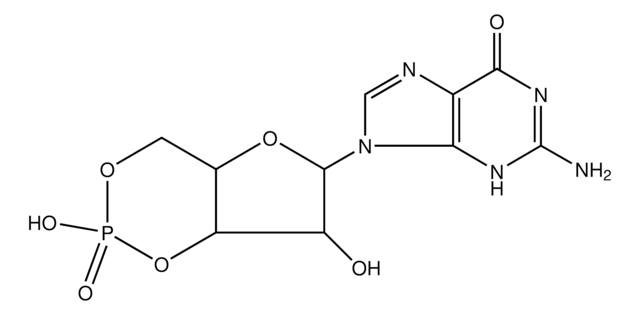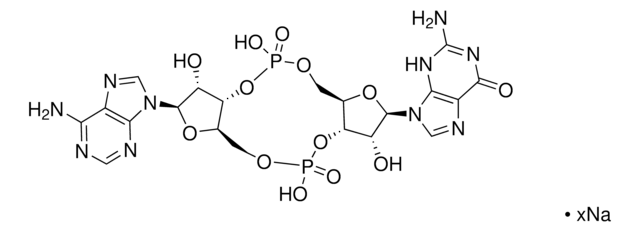A9376
Adenosine 2′:3′-cyclic monophosphate sodium salt
≥93%
Synonym(s):
2′,3′-cAMP sodium salt
Sign Into View Organizational & Contract Pricing
All Photos(3)
About This Item
Linear Formula:
C10H11N5O6PNa
CAS Number:
Molecular Weight:
351.19
EC Number:
MDL number:
UNSPSC Code:
41106305
eCl@ss:
32160414
PubChem Substance ID:
NACRES:
NA.51
Recommended Products
biological source
synthetic (organic)
Quality Level
Assay
≥93%
form
powder
solubility
water: 50 mg/mL, clear, colorless
storage temp.
−20°C
SMILES string
[Na+].Nc1ncnc2n(cnc12)[C@@H]3O[C@H](CO)[C@H]4OP([O-])(=O)O[C@@H]34
InChI
1S/C10H12N5O6P.Na/c11-8-5-9(13-2-12-8)15(3-14-5)10-7-6(4(1-16)19-10)20-22(17,18)21-7;/h2-4,6-7,10,16H,1H2,(H,17,18)(H2,11,12,13);/q;+1/p-1/t4-,6-,7-,10-;/m1./s1
InChI key
VSDSIACSNXHGOV-MCDZGGTQSA-M
Related Categories
Application
Adenosine 2′:3′-cyclic monophosphate sodium salt has been used in lysis buffer for affinity purification and also in microscale thermophoresis measurements. It has also been used in electrophysiological studies of Tenebrio tubules.
Biochem/physiol Actions
Adenosine 2′,3′-cyclic monophosphate (2′,3′-cAMP) is believed to serve as an extracellular source of adenosine. The release of extracellular 2′,3′-cAMP occurs in response to injury. 2′,3′-cAMP may be used to study the distribution and specificity of its degrading enzymes in the context of unique biological activities. 2′,3′-cAMP may also be used to study apoptosis induced at the level of mitochondrial permeability transition pores. 2′,3′-cAMP is converted into 2′-AMP and 3′-AMP which inhibit proliferation of preglomerular vascular smooth muscle cells and glomerular mesangial cells via A2B receptors.
Caution
Caution: Do not confuse with the common adenosine 2′(3′)-monophosphate (mixed isomers).
Storage Class Code
11 - Combustible Solids
WGK
WGK 3
Flash Point(F)
Not applicable
Flash Point(C)
Not applicable
Choose from one of the most recent versions:
Already Own This Product?
Find documentation for the products that you have recently purchased in the Document Library.
Customers Also Viewed
R P Ballestero et al.
The Journal of biological chemistry, 272(17), 11479-11486 (1997-04-25)
Biochemical characterization of changes in gene expression that accompany optic nerve regeneration has led to the identification of proteins that may play key roles in the regeneration process. In this report, a cDNA encoding gRICH70, a novel isoform of the
Jin Ren et al.
The Journal of pharmacology and experimental therapeutics, 328(3), 855-865 (2008-11-27)
We recently developed a sensitive assay for 3',5'-cAMP using high-performance liquid chromatography-tandem mass spectrometry. Using this assay, we investigated the release of 3',5'-cAMP from isolated, perfused rat kidneys. To our surprise, we observed a dominant chromatographic peak that was because
Interaction of 2′, 3′-cAMP with Rbp47b plays a role in stress granule formation.
Kosmacz M, et al.
Plant Physiology, pp-00285 (2018)
S G Srivatsan et al.
Chemistry (Weinheim an der Bergstrasse, Germany), 8(22), 5184-5191 (2003-03-05)
We have synthesized and characterized novel, copper-metalated, polymeric templates that contain adenine nucleobases. These promote hydrolysis of non-natural and natural phosphate ester substrates in a highly efficient and catalytic fashion. The crystal structure of the cooper-containing adenylated monomer reveals the
Sandrine Evellin et al.
Methods in molecular biology (Clifton, N.J.), 284, 259-270 (2004-06-03)
cAMP is a ubiquitous second messenger that controls numerous cellular events including movement, growth, metabolism, contraction, and synaptic plasticity. With the emerging concept of compartmentalization of cAMP-dependent signaling, a detailed study of the spatio-temporal intracellular dynamics of cAMP is required.
Our team of scientists has experience in all areas of research including Life Science, Material Science, Chemical Synthesis, Chromatography, Analytical and many others.
Contact Technical Service
